Insight into the Effect of TDMs on the Tribological Behaviors of the Ionic Liquid Composite Films
Abstract
1. Introduction
2. Materials and Methods
2.1. Preparation of the IL Composite Films
2.2. Characterization
2.3. Tribological Tests
3. Results and Discussion
4. Conclusions
Supplementary Materials
Author Contributions
Funding
Conflicts of Interest
References
- Izabela, S.; Michael, C.; Robert, W.C. Recent advances in single-asperity nanotribology. J. Phys. D Appl. Phys. 2008, 41, 123001. [Google Scholar]
- Bhushan, B.; Israelachvili, J.N.; Landman, U. Nanotribology: Friction, wear and lubrication at the atomic scale. Nature 1995, 374, 607–616. [Google Scholar]
- Bhushan, B. Nanotribology and nanomechanics of MEMS/NEMS and bioMEMS/BioNEMS materials and devices. In Nanotribology and Nanomechanics: An Introduction; Springer: Cham, Switzerland, 2017; pp. 797–907. [Google Scholar]
- Ye, C.; Liu, W.; Chen, Y.; Yu, L. Room-temperature ionic liquids: A novel versatile lubricant. Chem. Commun. 2001, 21, 2244–2245. [Google Scholar] [CrossRef]
- Bonhote, P.; Dias, A.P.; Papageorgiou, N.; Kalyanasundaram, K.; Grätzel, M. Hydrophobic, highly conductive ambient-temperature molten salts. Inorg. Chem. 1996, 35, 1168–1178. [Google Scholar] [CrossRef] [PubMed]
- Yu, B.; Zhou, F.; Mu, Z.; Liang, Y.; Liu, W. Tribological properties of ultra-thin ionic liquid films on single-crystal silicon wafers with functionalized surfaces. Tribol. Intern. 2006, 39, 879–887. [Google Scholar] [CrossRef]
- Somers, A.; Howlett, P.; MacFarlane, D.; Forsyth, M. A review of ionic liquid lubricants. Lubricants 2013, 1, 3–21. [Google Scholar] [CrossRef]
- Mo, Y.; Yu, B.; Zhao, W.; Bai, M. Microtribological properties of molecularly thin carboxylic acid functionalized imidazolium ionic liquid film on single-crystal silicon. Appl. Surf. Sci. 2008, 255, 2276–2283. [Google Scholar]
- Bhushan, B.; Palacio, M.; Kinzig, B. AFM-based nanotribological and electrical characterization of ultrathin wear-resistant ionic liquid films. J. Colloid Interf. Sci. 2008, 317, 275–287. [Google Scholar] [CrossRef] [PubMed]
- Lertola, A.C.; Wang, B.; Li, L. Understanding the friction of nanometer-thick fluorinated ionic liquids. Ind. Eng. Chem. Res. 2018, 57, 11681–11685. [Google Scholar]
- Zhao, W.; Pu, J.; Yu, Q.; Zeng, Z.; Wu, X.; Xue, Q. A novel strategy to enhance micro/nano-tribological properties of DLC film by combining micro-pattern and thin ionic liquids film. Colloids Surf. A Physicochem. Eng. Asp. 2013, 428, 70–78. [Google Scholar]
- Zhao, W.; Wang, Y.; Wang, L.; Bai, M.; Xue, Q. Influence of heat treatment on the micro/nano-tribological properties of ultra-thin ionic liquid films on silicon. Colloids Surf. A Physicochem. Eng. Asp. 2010, 361, 118–125. [Google Scholar] [CrossRef]
- Zhang, L.; Pu, J.; Wang, L.; Xue, Q. Frictional dependence of graphene and carbon nanotube in diamond-like carbon/ionic liquids hybrid films in vacuum. Carbon 2014, 80, 734–745. [Google Scholar] [CrossRef]
- Pu, J.; Wan, S.; Zhao, W.; Mo, Y.; Zhang, X.; Wang, L.; Xue, Q. Preparation and tribological study of functionalized graphene-IL nanocomposite ultrathin lubrication films on Si substrates. J. Phys. Chem. C 2011, 115, 13275–13284. [Google Scholar] [CrossRef]
- Pu, J.; Huang, D.; Wang, L.; Xue, Q. Tribology study of dual-layer ultrathin ionic liquid films with bonded phase: influences of the self-assembled underlayer. Colloids Surf. A Physicochem. Eng. Asp. 2010, 372, 155–164. [Google Scholar] [CrossRef]
- Zhao, W.; Zhu, M.; Mo, Y.; Bai, M. Effect of anion on micro/nano-tribological properties of ultra-thin imidazolium ionic liquid films on silicon wafer. Colloids Surf. A Physicochem. Eng. Asp. 2009, 332, 78–83. [Google Scholar] [CrossRef]
- Lv, M.; Han, F.; Wang, Q.; Wang, T.; Liang, Y. The structure properties and tribological behavior of the ionic liquid-polyimide composite films under high-vacuum environment. High Perform. Polym. 2017, 29, 170–177. [Google Scholar] [CrossRef]
- Rasheed, A.K.; Khalid, M.; Rashmi, W.; Gupta, T.C.S.M.; Chan, A. Graphene based nanofluids and nanolubricants-review of recent developments. Renew. Sustain. Energy Rev. 2016, 63, 346–362. [Google Scholar] [CrossRef]
- Xu, Y.; Peng, Y.; Dearn, K.D.; Zheng, X.; Yao, L.; Hu, X. Synergistic lubricating behaviors of graphene and MoS2 dispersed in esterified bio-oil for steel/steel contact. Wear 2015, 342–343, 297–309. [Google Scholar] [CrossRef]
- Zhang, W.; Cao, Y.; Tian, P.; Guo, F.; Tian, Y.; Zheng, W.; Ji, X.; Liu, J. Soluble exfoliated two-dimensional nanosheets as excellent aqueous lubricants. ACS Appl. Mater. Int. 2016, 8, 32440–32449. [Google Scholar] [CrossRef]
- Wu, X.; Gong, K.; Zhao, G.; Lou, W.; Wang, X.; Liu, W. Surface modification of MoS2 nanosheets as effective lubricant additives for reducing friction and wear in poly-α-olefin. Ind. Eng. Chem. Res. 2018, 57, 8105–8114. [Google Scholar] [CrossRef]
- Zhao, W.; Zeng, Z.; Peng, S.; Wu, X.; Xue, Q.; Chen, J. Fabrication and investigation the microtribological behaviors of ionic liquid-graphene composite films. Tribol. T 2013, 56, 480–487. [Google Scholar] [CrossRef]
- Palacio, M.; Bhushan, B. Ultrathin wear-resistant ionic liquid films for novel MEMS/NEMS applications. Adv. Mater. 2008, 20, 1194–1198. [Google Scholar] [CrossRef]
- Wang, Y.; Cao, X.A.; Lang, H.; Zeng, X.; Chen, B.; Chen, R.; Peng, Y. Enhanced Tribological properties of composite films based on ionic liquids with MoS2 nanosheets as additives. N. J. Chem. 2018, 42, 4887–4892. [Google Scholar] [CrossRef]
- Zhao, J.; He, Y.; Wang, Y.; Wang, W.; Yan, L.; Luo, J. An investigation on the tribological properties of multilayer graphene and MoS2 nanosheets as additives used in hydraulic applications. Tribol. Int. 2016, 97, 14–20. [Google Scholar] [CrossRef]
- Splendiani, A.; Sun, L.; Zhang, Y.; Li, T.; Kim, J.; Chim, C.Y.; Galli, G.; Wang, F. Emerging photoluminescence in monolayer MoS2. Nano Lett. 2010, 10, 1271–1275. [Google Scholar] [CrossRef]
- Stankovich, S.; Dikin, D.A.; Piner, R.D.; Kohlhaas, K.A.; Kleinhammes, A.; Jia, Y.; Wu, Y.; Nguyen, S.T.; Ruoff, R.S. Synthesis of graphene-based nanosheets via chemical reduction of exfoliated graphite oxide. Carbon 2007, 45, 1558–1565. [Google Scholar] [CrossRef]
- Liang, S.; Shen, Z.; Yi, M.; Liu, L.; Zhang, X.; Ma, S. In-situ exfoliated graphene for high-performance water-based lubricants. Carbon 2016, 96, 1181–1190. [Google Scholar] [CrossRef]
- Berman, D.; Erdemir, A.; Sumant, A.V. Reduced wear and friction enabled by graphene layers on sliding steel surfaces in dry nitrogen. Carbon 2013, 59, 167–175. [Google Scholar] [CrossRef]
- Chua, C.K.; Pumera, M. Covalent chemistry on graphene. Chem. Soc. Rev. 2013, 42, 3222–3233. [Google Scholar] [CrossRef]
- Jiang, J.W. Graphene versus MoS2: A short review. Front. Phys. 2015, 10, 287–302. [Google Scholar] [CrossRef]

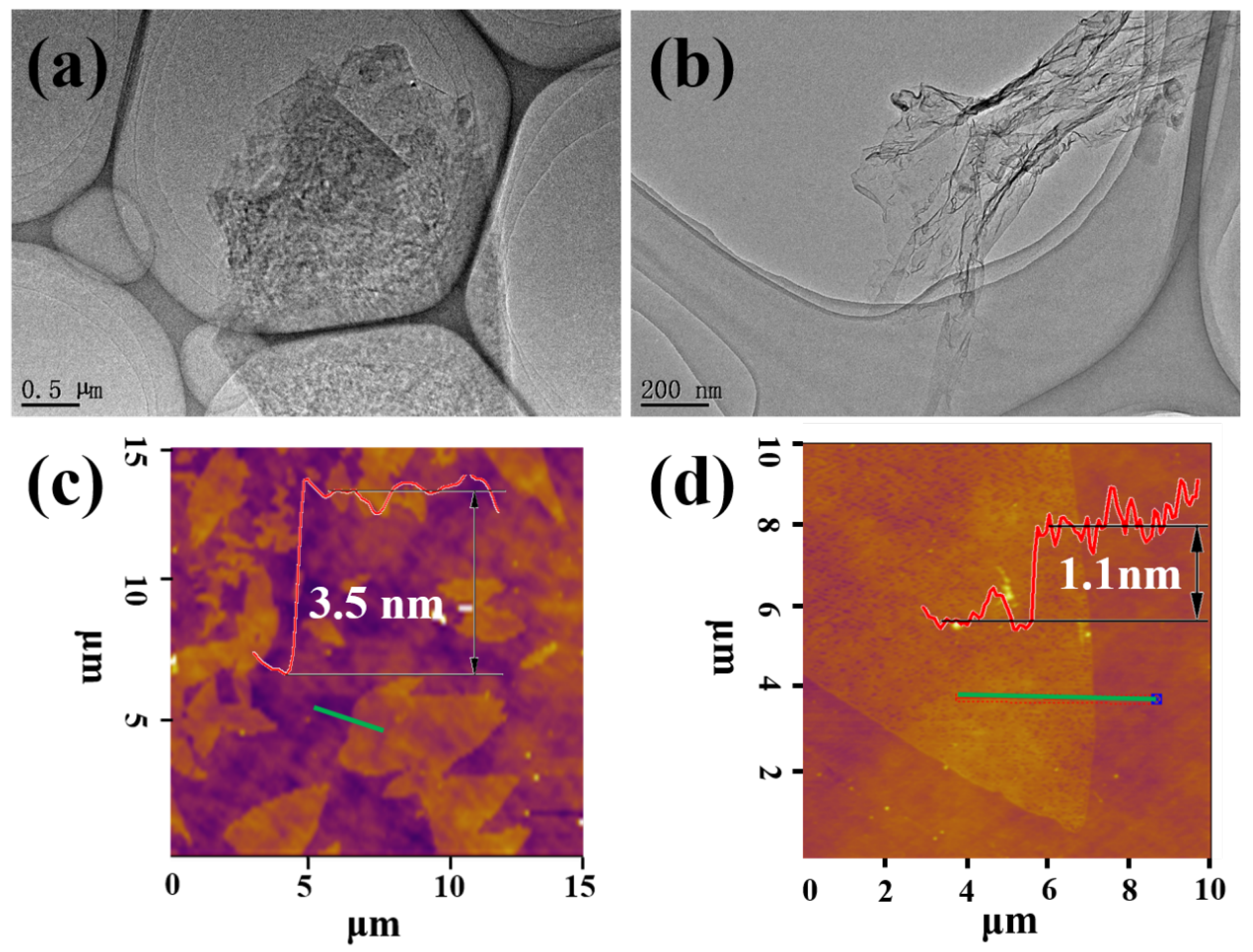
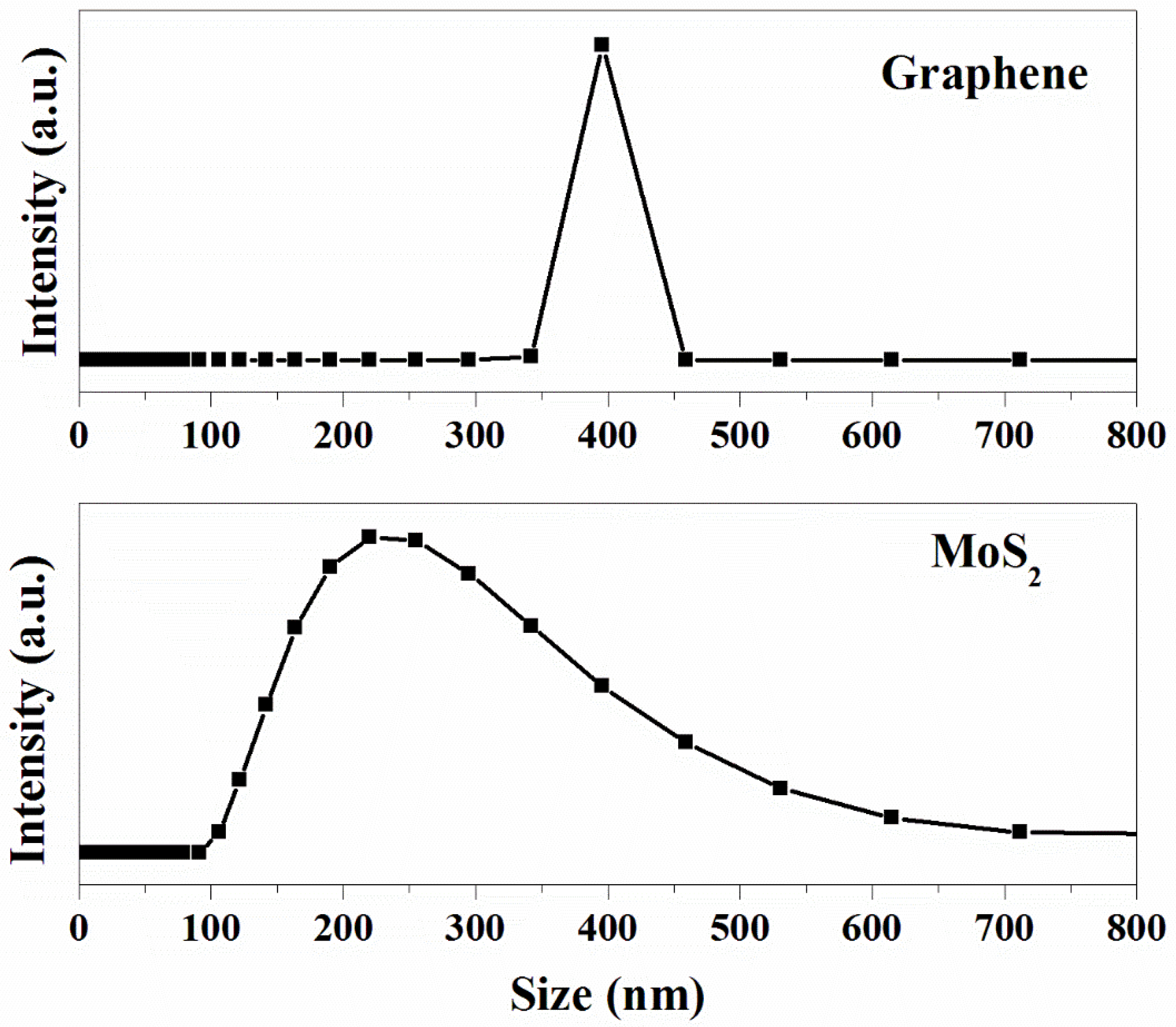

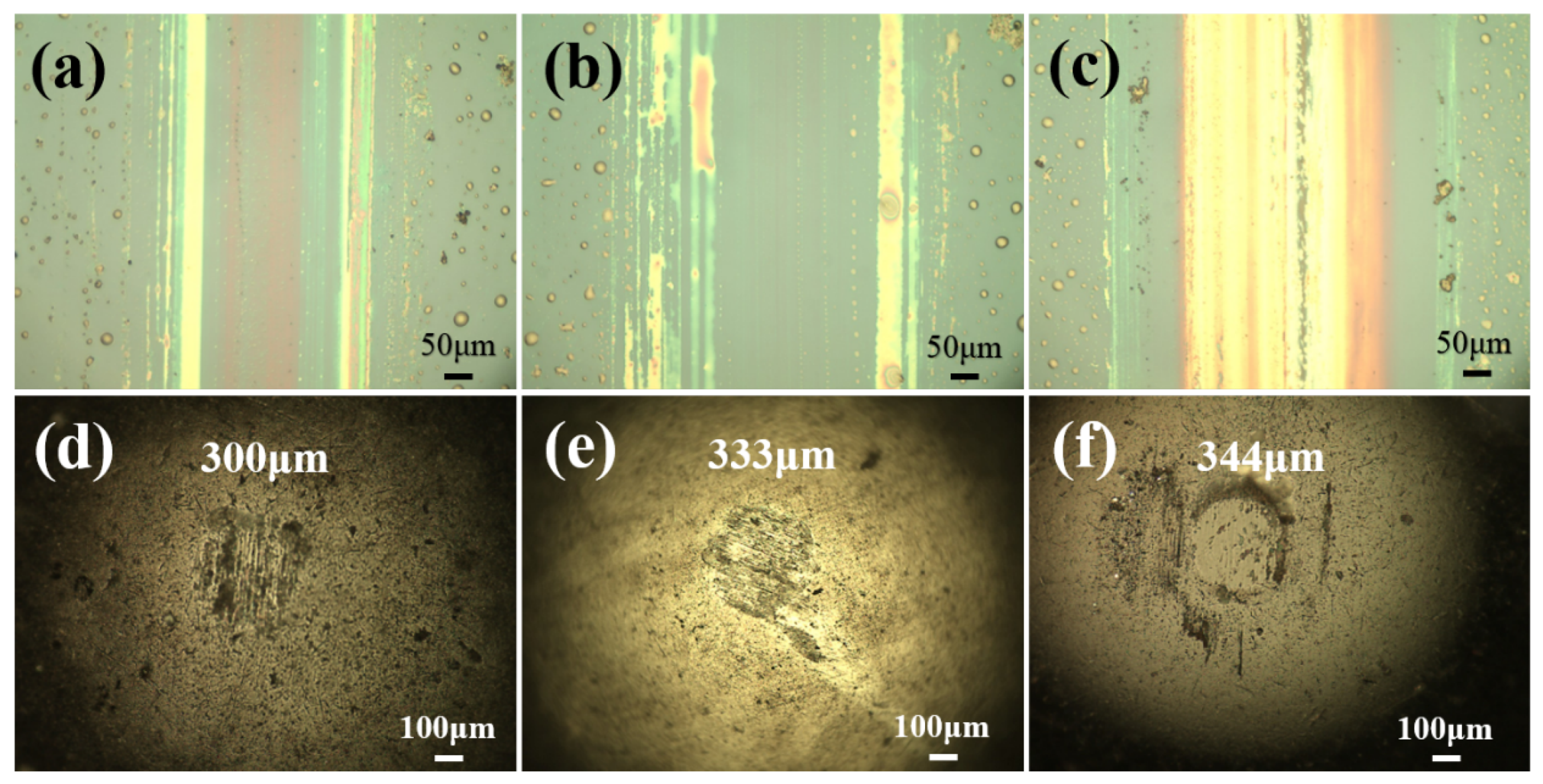
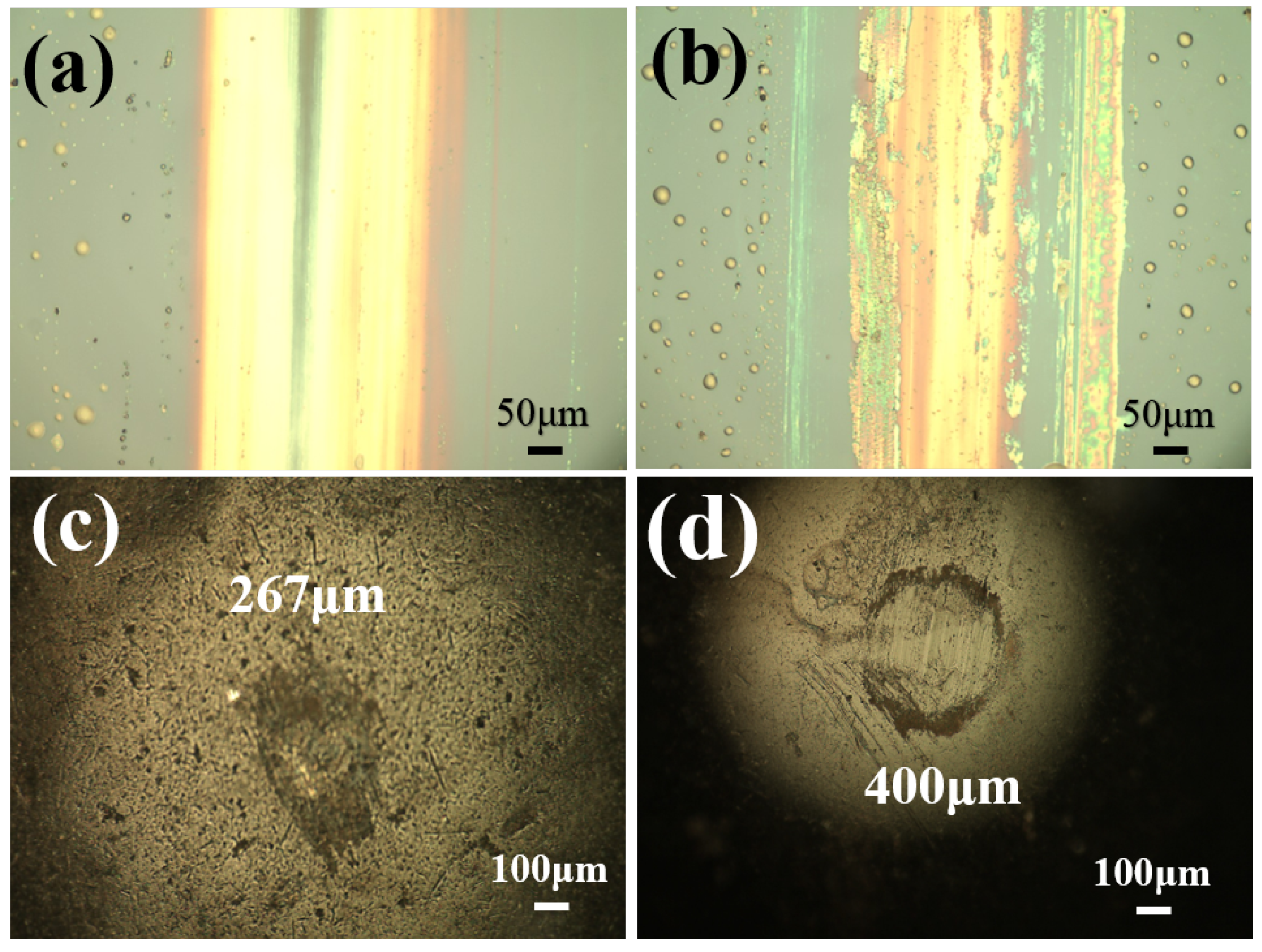
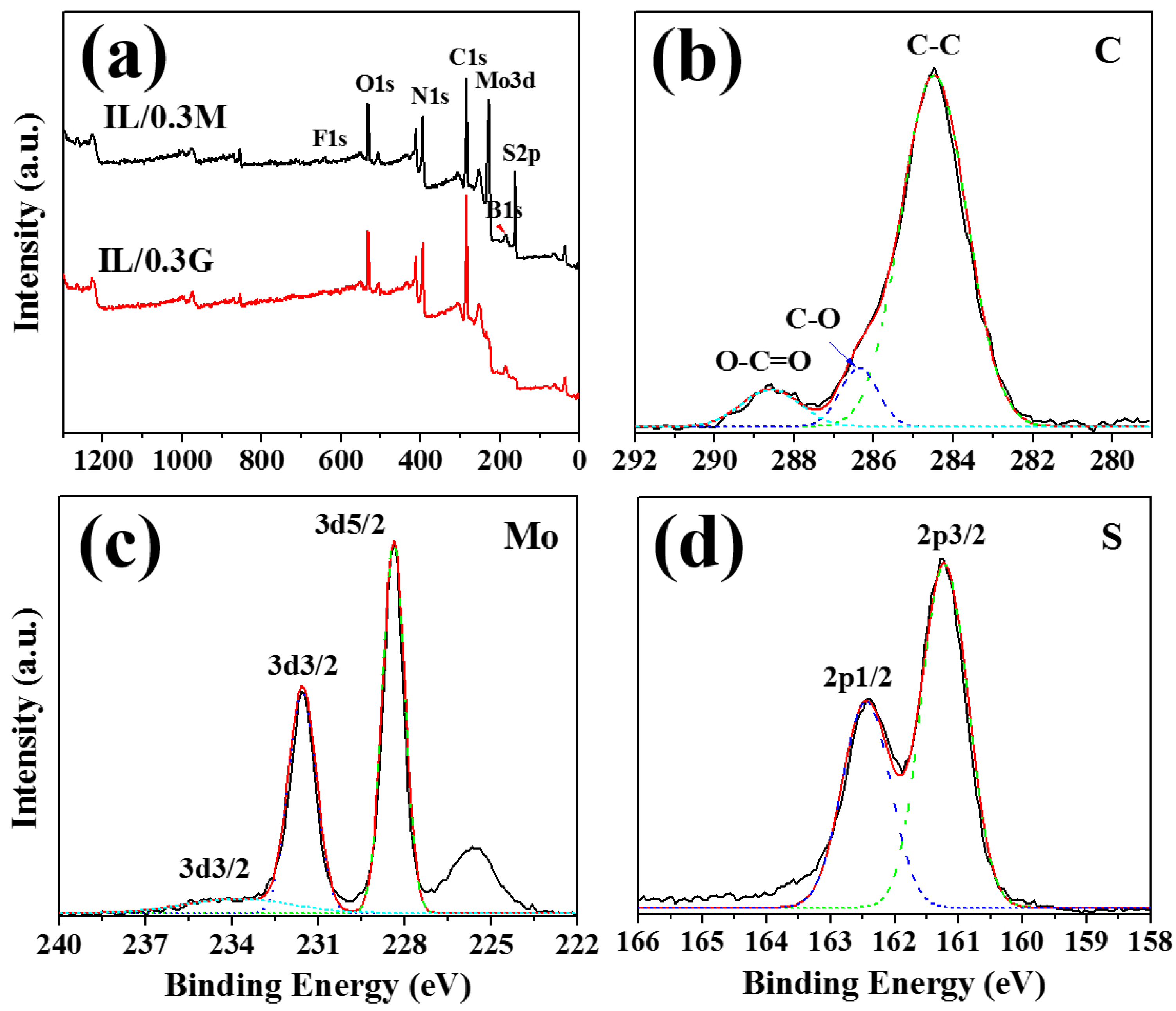
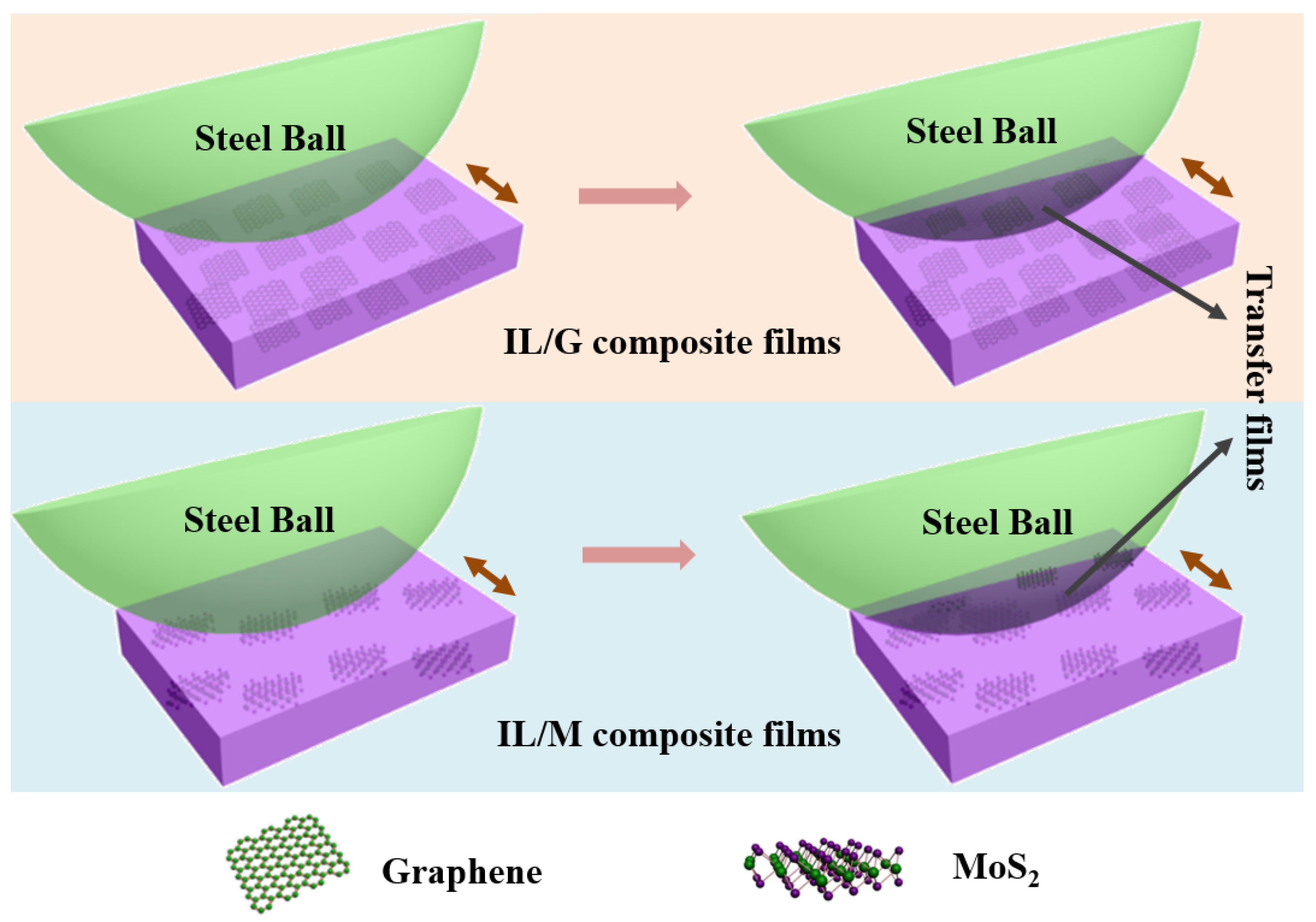
| IL/0.3M | IL/0.5M | IL/1M | IL/0.1G | IL/0.3G | |
|---|---|---|---|---|---|
| r (mm) | 3 | 3 | 3 | 3 | 3 |
| d (mm) | 0.3 | 0.333 | 0.344 | 0.267 | 0.4 |
| h (um) | 375 | 462 | 493 | 297 | 667 |
| V ( mm) | 133 | 201 | 229 | 83 | 419 |
© 2020 by the authors. Licensee MDPI, Basel, Switzerland. This article is an open access article distributed under the terms and conditions of the Creative Commons Attribution (CC BY) license (http://creativecommons.org/licenses/by/4.0/).
Share and Cite
Qi, Y.; Zhang, L.; Wang, Y. Insight into the Effect of TDMs on the Tribological Behaviors of the Ionic Liquid Composite Films. Materials 2020, 13, 191. https://doi.org/10.3390/ma13010191
Qi Y, Zhang L, Wang Y. Insight into the Effect of TDMs on the Tribological Behaviors of the Ionic Liquid Composite Films. Materials. 2020; 13(1):191. https://doi.org/10.3390/ma13010191
Chicago/Turabian StyleQi, Ya’e, Ling Zhang, and Yongxia Wang. 2020. "Insight into the Effect of TDMs on the Tribological Behaviors of the Ionic Liquid Composite Films" Materials 13, no. 1: 191. https://doi.org/10.3390/ma13010191
APA StyleQi, Y., Zhang, L., & Wang, Y. (2020). Insight into the Effect of TDMs on the Tribological Behaviors of the Ionic Liquid Composite Films. Materials, 13(1), 191. https://doi.org/10.3390/ma13010191




